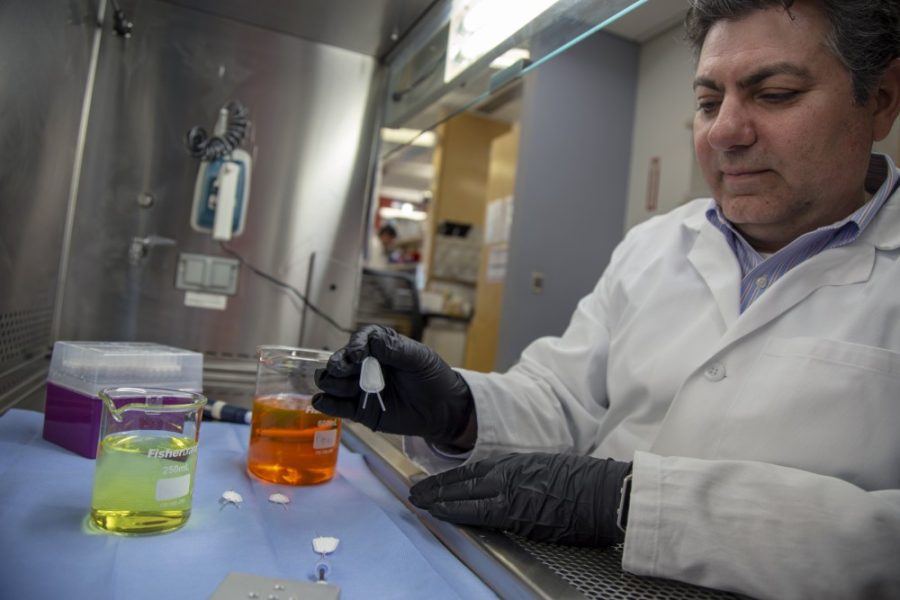*This article has been corrected to reflect more accurate information about both the oxygen-enhanced implantable device and the team of scientists working on it.
Klearchos Papas, a University of Arizona professor in the department of surgery, is leading a team to develop a new way to treat Type 1 diabetes. The treatment would release insulin into a person when an oxygen-enhanced implantable device senses their glucose level is too low.
The device would also remove the need for immunosuppression, which current treatments require. In immunosuppression, the patient’s immune system is permanently suppressed to allow for outside cells to be introduced, which can lead to increased risk of infection.
Papas has worked for the UA since 2011 and is the director of the Institute for Cellular Transplantation. He has been heading this research at the UA and developing the implantable device in collaboration with researchers and scientists worldwide.
RELATED: Researchers work to improve Parkinson’s disease treatment
The device is building on a current treatment called islet transplantation, which is a medical innovation that allows adults with Type 1 diabetes to receive islets from donors through the liver, which then begin to produce insulin for the body. However, this method still requires life-long suppression of the immune system, because the cells come from a different human donor and will be rejected if the recipient’s immune system is not suppressed, according to Papas. This makes the treatment less suitable for more vulnerable patients like children.
The device Papas is developing is a variation of a device known as a “tea bag” that protects the transplanted islets from being attacked by the body’s immune system. The tea bag device was first developed by a team of scientists at Baxter led by Robert Johnson, a research professor in the Institute for Cellular Transplantation at the UA, in the 1990s. Johnson is a Type 1 diabetic, diagnosed in 1969, and has been conducting research on diabetes throughout his career.
The version Papas is working on allows more oxygen to reach the “tea bag” without increasing the size of the device, which can improve the ability of the islets to produce insulin and also remove the need for immunosuppression. As another obstacle to islet transplantation is the limited amount of islets available, improving the ability of the donated islets to produce insulin means less would be needed per person.
“An issue with applying this to the larger scale is it requires human islets from human organs,” Papas said. “There are only about 5,000 donors available in the U.S., and there are millions of people who could potentially benefit.”
However, over the years the work of various other scientists has led to the recent creation of lab-grown islets, allowing for a more abundant source of cells that can be used for this research and the treatment of millions of people.
“Several companies and groups have succeeded recently in making cells that release insulin in response to glucose like the normal beta cells,” Papas said. “[It’s] not quite there yet, but it’s very close.”
Johnson said he came out of retirement to join Papas at UA to further conduct this research once he learned of the breakthrough in the cell growth and of the further development of the “tea bag” oxygenated device.
The tea bag device will not be ready to go to clinical trials in humans for another three to five years, according to Papas. Current trials include testing the device on rodents and pigs.
Leah Steyn, assistant research scientist in the Institute for Cellular Transplantation, oversees animal research in the department of surgery. She has officially been working under Papas since 2015.
“We take [the devices] and load them with cells, or islets, and we actually transplant those into diabetic animals,” Steyn said. “We’re looking at reversing diabetes in animals with those devices as a proof of concept, and eventually that will go into humans.”
Steyn said they have had success in their testing on rodents, specifically rats, and were able to reverse the animal’s diabetes.
“We have our first diabetic pigs studies going right now, and they look pretty promising,” Steyn said.
Much of this work is funded through grants. Papas’ research has recently landed him a two-year, $1.2 million grant from Juvenile Diabetes Research Foundation to continue his research.
Papas said as the research moves closer to being ready for human testing, the work gets more expensive and more intense. He added, along with funding from JDRF, he also receives funding from National Institutes of Health. Early stages of the research were supported by other JDRF and NIH — National Institute of Diabetes and Digestive and Kidney Diseases grants.
RELATED: Researchers opened labs to public for BIO5 open house
“Each one of them covers a piece of the puzzle,” Papas said.
Tech Launch Arizona has also played a role in supporting the development of the device, helping Papas form the company Procyon Technologies, LLC. The company will help to commercialize the product later on.
Papas said Dr. Leigh Neumayer, chair of the Department of Surgery, and Dr. Robert Harland, surgical director of solid organ transplantation at UA, have been integral to the project’s success.
He also said the support of President Dr. Robert Robbins and Provost Jeffrey Goldberg was appreciated, along with UA Health Sciences leadership, including Senior Vice President Michael Dake, Interim Vice President for Research Kim Ogden, Interim Executive Dean of the College of Medicine Irving Kron, Director of the BIO5 Institute Jennifer Barton and the UAHS Executive Director of Biomedical Corporate Alliances Rick Silva.
Follow Quincy Sinek on Twitter














